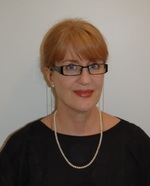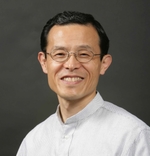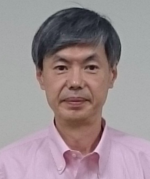5-1 Pathways to Developing a Translation Specialty
トンプキンス・ベン(Ben Tompkins)
Ben Tompkins lives in beautiful Fukuoka, Japan, where he began translating professionally in 1994. Ben specializes in pharmaceutical and biomedical translation. He owns Tompkins Biomedical Communications, a provider of translation and other language services to pharmaceutical companies, research organizations, and universities. Ben serves as Vice President of the Japan Association of Translators (JAT) and has helped organize three IJET conferences in and outside Japan.
ローソン・キャロル(Carol Lawson)
Carol Lawson serves as the Chair of JATLAW, the legal translation chapter of the Japan Association of Translators and is currently undertaking a Ph.D. in Japanese law at the Australian National University. She has recently completed four years as part of Australia’s translator accreditation (NAATI) Japanese Examiner Panel, and taught Japanese to English legal translation to final semester students completing the University of Queensland Masters in Japanese Interpreting and Translating (MAJIT) for ten years, while also teaching comparative legal writing at Nagoya University for four years. Ms. Lawson holds Masters’ degrees in Japanese law and translation studies, and is qualified to practice law in Australia.
時國 滋夫(George Tokikuni)
George Tokikuni has been working in the translation world since 1988, first as a technical translator and later as a patent translator in electronics, which he learned while working for a Japanese electric company for nine years. He also teaches English at universities and patent translation when asked.
斉藤 亜紀良(Saito Akira)
Akira Saito was born in Tokyo and lived there until receiving a Doctoral degree in pharmaceutical sciences (Univ. of Tokyo). He has been engaged in pharmacology research activities in academia (Southern Illinois Univ., USA, and Univ. of Tsukuba, Japan) and industry (Mitsubishi Tanabe Pharma, Japan).
報告者:渡邊 健(インハウス翻訳者)
If you’re around 30 and plan to translate for another 30 years, you might spend 50,000 hours of your life in front of a computer translating other people’s words. If you want to enjoy those hours, you should consider specializing in a certain field. The three panelists—Ms. Lawson, Mr. Tokikuni, and Dr. Saito—provided valuable tips about specializing.
Challenges and rewards of legal translation
One benefit of legal translation is that its pay rates are significantly higher than generalists’ work. Legal translation most suits to those who are meticulous and able to recognize and replicate patterns, and understand the need to achieve consistency—with both the wider corpus of existing legal texts and within a single legal document.
If you start training as a legal translator without any legal background, the learning curve at the beginning will be very steep—almost vertical, so it looks like a hockey stick when graphed. There are three types of legal systems in the world—common law, civil law, socialist legal systems. J-E legal translators have to translate civil law legal concepts into a language used primarily by common law lawyers. This means that you have to understand the differences between these two legal systems, or you may make serious mistakes.
In terms of marketing, the very best marketing activity is a top-quality service delivered on time. Judging from my experience, turning down work well can also be fabulous marketing; if you are approached regarding a document you are not comfortable working on, you can entrust it to a more suitable colleague and create goodwill for the future that way.
現役の特許翻訳家へ
自分の訳文を読んで「何か変だ」と思ったら、誤訳があると考えるべき。この「変だ」と思う感覚を大切にし、「変だ」と思ったまま訳文を提出してはならない。そのために、JATやJTF等の翻訳業界団体に加入して、相談できる同僚を持つべきだ。また、特許翻訳が顧客に提出された後も、翻訳文書は、担当者、発明者、patent attorney、patent agent等の目にも触れる。これらの人たちと積極的に話をし、それぞれのニーズを理解することが非常に有益だ。
特許翻訳家を志す方へ
特許翻訳を志望する場合、まず、①機械、②電子工学、③化学、④バイオの四分野の中から好きなものを選ぶこと。専門分野を決めたら、その分野の特許明細書を日本語と英語で三本ずつ読むこと。そして、特許明細書を読んで「面白い」と思った人は、特許翻訳に向いている。次のステップとして、自分で決めた分野の概説書を英語と日本語で読むこと。その他には、単語と文法をよく知っていること、辞書を多く持ち、それをよく引くことも大切だ。
製薬・医薬翻訳について
医薬翻訳では、発信者と読者ともに専門性が高く、一つの文書の読者数は世界で数十人ほど。翻訳される文書は、試験報告書、申請書類、学術論文等と多岐にわたり、ニーズも高い。翻訳者が訳した文書は、クロスチェックを経た上でクライアントに戻される。有害事象の専門用語はMedDRAを使うことが多く、定型的用語の場合には対訳ソフトを使うと便利だ。
報告書や論文を訳す際には、時制への配慮が重要。具体的には、科学的事実を述べるときと、図形や計算を参照するときは現在形を使い、試験方法や試験結果は過去形を使う。また要約、序文、方法、結果、考察のまとめ方も、臨床か非臨床かで異なる。必要最低限の情報のみを盛り込んだ所謂「ウナギ文」にも要注意だ。




